
|
|

April 3, 2009
Palm Springs, California (Part I)
Regular readers of Tower Site of the Week know that we're big fans of southern California. Its combination of interesting broadcast history, unusual sites, friendly engineering folks and warm sunshine (a big plus for a column based in upstate New York!) have drawn us back to the the Los Angeles and San Diego markets over and over again in the last few years, with no shortage of side trips to much of the surrounding territory.
But we'd long had a big gap east of San Bernardino, where the Palm Springs market kept coming up as a "one of these trips, we'll get there" sort of destination, and kept getting put off from year to year...until, that is, one of its stations began making plans to move out of the market, setting the stage for a format shuffle that threatened to silence a station we'd long been meaning to visit and aircheck.
So when we were making plans for our pre-NAB SoCal jaunt in April 2008, Palm Springs suddenly found itself up at the top of the list, and on a warm Friday afternoon we at last found ourselves heading out of San Diego to the north and east, arriving in the Coachella Valley just in time to catch our engineer friend Glen Kippel before he left for the day at the R&R Broadcasting cluster where he works most of the time.
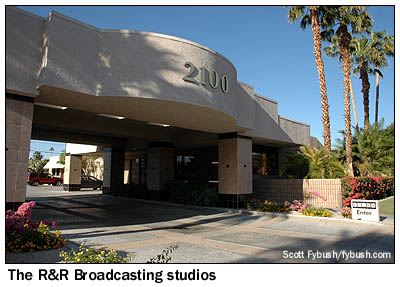
|
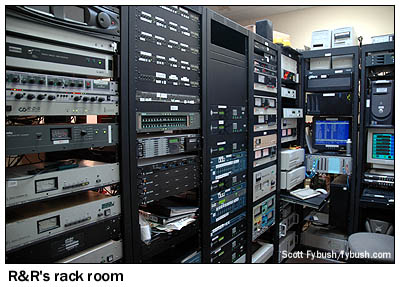
|
When we visited, the R&R building at 2100 E. Tahquitz Canyon Way was home to three AMs - talker KPSI (920 Palm Springs), progressive talker KPTR (1340 Cathedral City) and sports KGAM (1450 Palm Springs) - and two FMs, AC KPSI-FM (100.5 Palm Springs) and oldies KDES (104.7 Palm Springs), all clustered neatly together in a pod of studios at one end of the building.
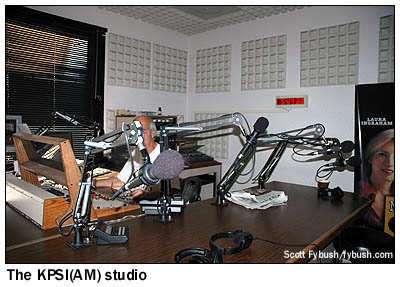
|
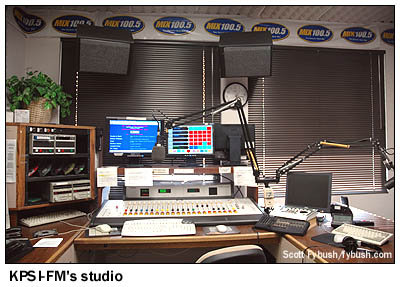
|
KDES, as it turns out, is our reason for making this trip, since it's applied to move west to Redlands, where it would downgrade from class B to class A, picking up millions of new potential listeners in the much larger Riverside/San Bernardino market. (That move seemed imminent when we were planning the 2008 trip, but a combination of the usual delays and some very loud opposition to the move from another signal on 104.7, KCAQ Oxnard, has delayed KDES' relocation.)
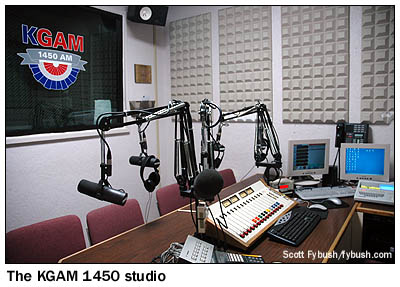
|
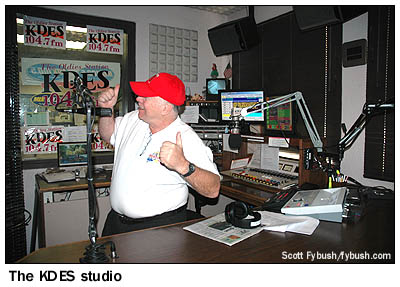
|
So why travel all that way just to hear an oldies station? We didn't. (Though with guys like KRLA veteran Russ O'Hara, above, on the air, KDES is a great-sounding station.)
You see, once the 104.7 move is complete, the plan is to keep the KDES oldies format alive - but down the dial on the big 98.5 FM signal licensed to nearby Cathedral City. It's that station we really wanted to hear, and to visit, because in its current incarnation, it's one of the last survivors of an era of radio that's all but gone. And fortunately for us, it's also one of Glen's engineering clients; indeed, he's been associated with the station, KWXY, since the sixties.
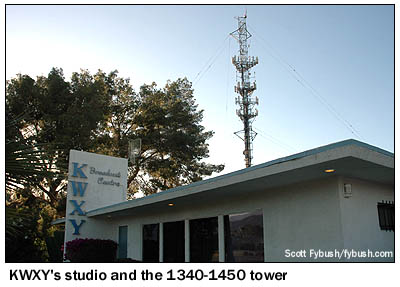
|
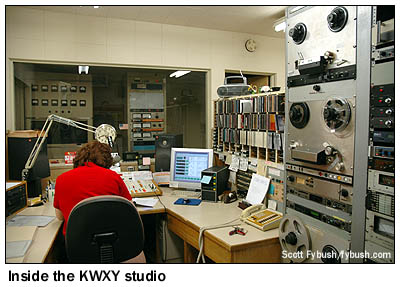
|
98.5 is, at least for the moment, an honest-to-Mantovani beautiful music station, complete with songs being played off open-reel tape and a lineup of live, local jocks that includes none other than Dave "The Hullaballooer" Hull, the Los Angeles top-40 veteran who retired to Palm Springs but never stopped doing radio.
Dave is just starting his evening airshift when we get out to the KWXY studio on Dinah Shore Boulevard in Cathedral City, in a lovely little building that's a time capsule from an earlier era of radio - a big office area in front, a production studio and air studio off to the left of the entrance, with the old KWXY(AM) Raytheon transmitter (in use on the station's first day, October 4, 1964) visible through the glass beyond, right next to the 3 kW Standard FM transmitter that's still capable of being used as a backup for KWXY-FM. There's an addition in back for more sales offices.
(KWXY's former AM is now KPTR on 1340; it and KGAM 1450 are diplexed into the tower out back, which is festooned with dozens of cell-phone antennas as well.)
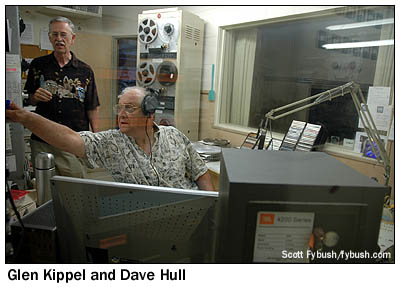
|
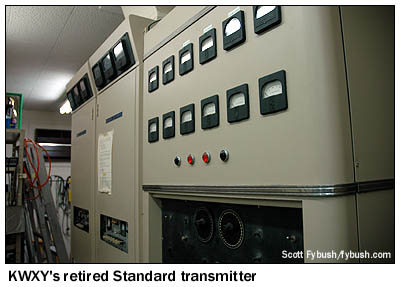
|
If ever there were a market custom-made for the survival of beautiful music in the 21st century, it should be Palm Springs, where the median age is rather older than the rest of the country, and the level of disposable income among the senior set is rather higher than average. And indeed, for as long as it survives, KWXY-FM is doing just fine, pulling in lots of listeners and plenty of advertisers. It will be a sad day when it yields up its big class B FM signal to KDES, if in fact that plan still gets carried out; word is that the KWXY calls will get moved back down to their original home on AM 1340, but probably without the local talent (not just Dave Hull, but also weekend guy Don Wardell, a veteran of the BBC and Radio Luxembourg) that helps to make the FM an interesting listen even for your thirty-something editor.
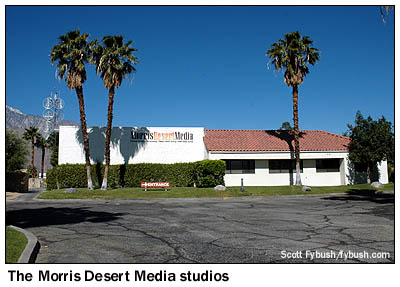
|
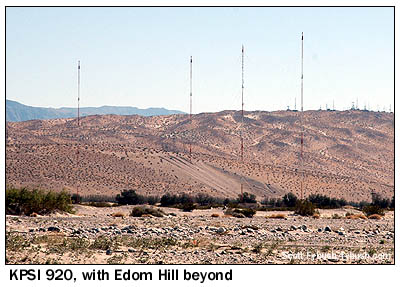
|
After our KWXY tour, we follow Glen for some great Mexican food for dinner, but our Palm Springs radio tourism is far from finished.
That's what Saturday morning is for, as we head north from our hotel on the south side of Palm Springs toward the hills that define the northern edge of the valley, where I-10 cuts its way from LA to Arizona. Just south of the Palm Canyon Drive exit of I-10, we find the studios of another big cluster, Morris Desert Media, home to sports KXPS (1010 Thousand Palms), news-talk "K-News" KNWQ (1140 Palm Springs)/KNWZ (970 Coachella)/KNWH (1250 Yucca Valley), ESPN Deportes KFUT (1270 Thousand Palms), urban "U-92.7" KKUU (92.7 Indio), rock KCLB (93.7 Coachella) and classic hits "Eagle" KDGL (106.9 Yucca Valley).
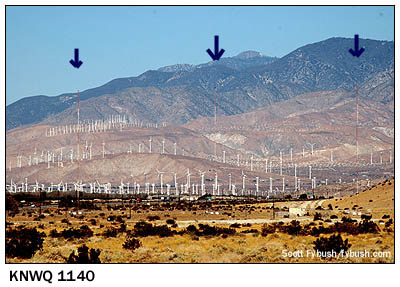 Just
to the east across Palm Canyon Drive, we see the four towers
of KPSI (920), running 5 kW days/1 kW nights, and beyond them,
to the north, the TV/FM tower farm up on Edom Hill, which we'll
explore in more detail in next week's installment.
Just
to the east across Palm Canyon Drive, we see the four towers
of KPSI (920), running 5 kW days/1 kW nights, and beyond them,
to the north, the TV/FM tower farm up on Edom Hill, which we'll
explore in more detail in next week's installment.
The Morris AMs are all located on the relatively undeveloped north side of I-10, and their skinny towers are not easy to see in the bright sunlight, especially against the desert hills that rise behind them in the background.
That might explain why our pictures of the KNWQ (1140) site, the westernmost of the Palm Springs AMs, ended up featuring just three of the five towers that make up that array, which runs 10 kW days, 2500 watts nights, DA-N. (And all those wind turbines, just a tiny fraction of the immense wind farm that lines the I-10 corridor west of Palm Springs, didn't help set off the towers, either.)
We did get all five towers of KXPS (1010), the next site to the east, in the frame - but it took some sharpening and contrast manipulation to bring them out even enough to label them for the photo below. This is one of the market's newer stations, dating only to the late eighties, with 3600 watts by day, 400 watts at night. About a mile to the northeast sits the two-tower array of KFUT (1270), which runs 5 kW days/750 watts nights.
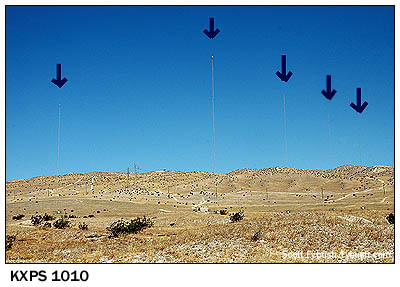
|
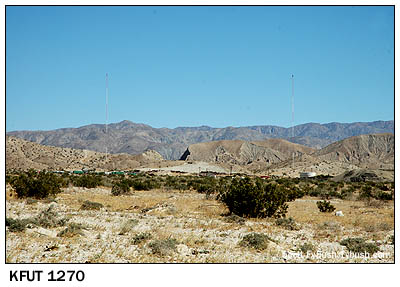
|
And that's hardly it for this interesting market - we've got much more Palm Springs to show you in next week's installment, including the Edom Hill tower farm, the market's TV studios, a few more AMs on the eastern end of the Coachella Valley, and some highlights of the drive back to LA.
- Previous Site of the Week: KGB and KOGO, San Diego
- Next Week: Palm Springs, California (Part II)
- Site of the Week INDEX!
- How can you help support Site of the Week? Click here!
- Submit your suggestions for a future Site of the Week!
